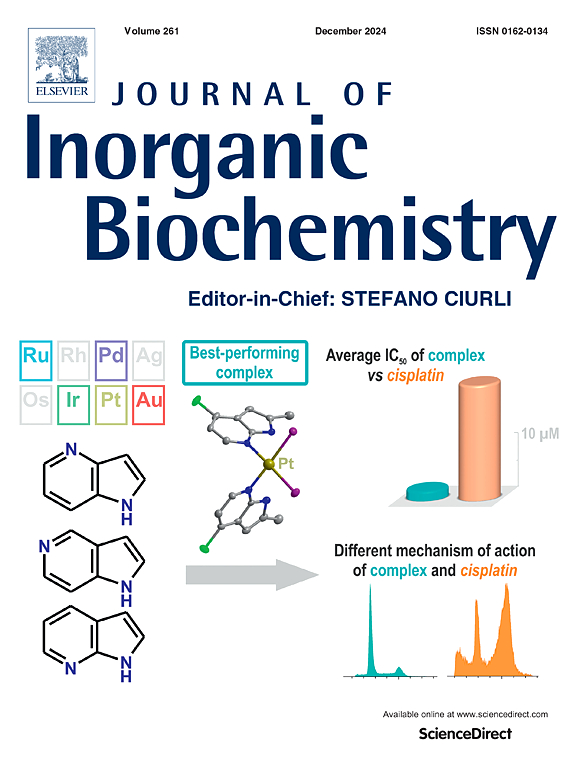Pt(II)非氧化还原依赖性上转换平台的近红外活化研究
IF 3.2
2区 化学
Q2 BIOCHEMISTRY & MOLECULAR BIOLOGY
引用次数: 0
摘要
上转换纳米粒子(UCNPs)是一类有趣的纳米材料,具有独特的多光子激发光致发光特性,作为生物医学成像和药物传递的新型造影剂已被广泛研究。近年来,光致药物释放装置的开发得到了大力发展,特别是利用UCNPs,因为它们具有吸收单波段近红外(NIR)光并随后发射高能紫外到可见光的特性,可以光激活几种前药。已经描述了一些Pt(II)释放的例子,它们都是利用Pt(IV)/(II)氧化还原对的Pt(IV)配合物释放的。在这项工作中,近红外光响应LiYF4:Yb/Tm UCNPs作为载体系统发挥光诱导Pt(II)药物释放。为此,在UCNPs表面涂覆两亲性聚合物,将疏水纳米颗粒转化为亲水纳米颗粒,并装载新型Pt(II)配合物。研究表明,近红外辐射诱导的Pt(II)药物释放可以实现,而无需使用Pt(IV)/(II)氧化还原偶对作为触发器。这样,在近红外激发下,UCNPs可以将近红外辐射转化为紫外辐射,从而在时空控制下直接释放Pt(II)药物。发布过程已被实时监控。我们研究了含有两种不同Pt(II)配合物的两种平台,在Pt(II)浓度增加引起的毒性增强方面都显示出相似的结果。此外,在这些平台照射后,观察到对黑色素瘤A375细胞的细胞毒性显著改善,证实了所提出的上转化过程释放Pt(II)的可行性。本文章由计算机程序翻译,如有差异,请以英文原文为准。

Near-infrared activation of upconversion platforms for non-redox-dependent release of Pt(II)
Upconversion nanoparticles (UCNPs) are a class of interesting nanomaterials with unique multi-photon excitation photoluminescence properties, and they have been intensively explored as novel contrast agents for biomedical imaging and drug delivery. The development of photoinduced drug-release devices has been intensively developed in the last years, specially using UCNPs due to their properties to absorb single-band near infrared (NIR) light and subsequently emit high-energy UV-to-visible light which could photoactivate several prodrugs. Some examples of Pt(II) release have been described, all of them from Pt(IV) complexes taking advantage of the Pt(IV)/(II) redox couple. In this work, NIR light-responsive LiYF4:Yb/Tm UCNPs are presented as carrier systems to exert photoinduced Pt(II) drug release. For this, the surface of UCNPs were coated with an amphiphilic polymer to convert hydrophobic nanoparticles into hydrophilic and to load novel Pt(II) complexes. It is demonstrated that NIR radiation-induced Pt(II) drug release can be achieved without the need to use the Pt(IV)/(II) redox couple as a trigger. In this way, under NIR excitation, UCNPs can transform NIR irradiation into UV radiation which causes direct Pt(II) drug release in a spatial and temporal control manner. The release process has been monitored in real-time. Two platforms containing two different Pt(II) complexes have been studied, both showing similar results in terms of the enhancement of toxicity caused by the increase in Pt(II) concentration. Furthermore, a significant improvement of cytotoxicity against melanoma A375 cells was observed after irradiation of these platforms, confirming the feasibility of the proposed upconversion process to release Pt(II).
求助全文
通过发布文献求助,成功后即可免费获取论文全文。
去求助
来源期刊

Journal of Inorganic Biochemistry
生物-生化与分子生物学
CiteScore
7.00
自引率
10.30%
发文量
336
审稿时长
41 days
期刊介绍:
The Journal of Inorganic Biochemistry is an established international forum for research in all aspects of Biological Inorganic Chemistry. Original papers of a high scientific level are published in the form of Articles (full length papers), Short Communications, Focused Reviews and Bioinorganic Methods. Topics include: the chemistry, structure and function of metalloenzymes; the interaction of inorganic ions and molecules with proteins and nucleic acids; the synthesis and properties of coordination complexes of biological interest including both structural and functional model systems; the function of metal- containing systems in the regulation of gene expression; the role of metals in medicine; the application of spectroscopic methods to determine the structure of metallobiomolecules; the preparation and characterization of metal-based biomaterials; and related systems. The emphasis of the Journal is on the structure and mechanism of action of metallobiomolecules.
 求助内容:
求助内容: 应助结果提醒方式:
应助结果提醒方式:


